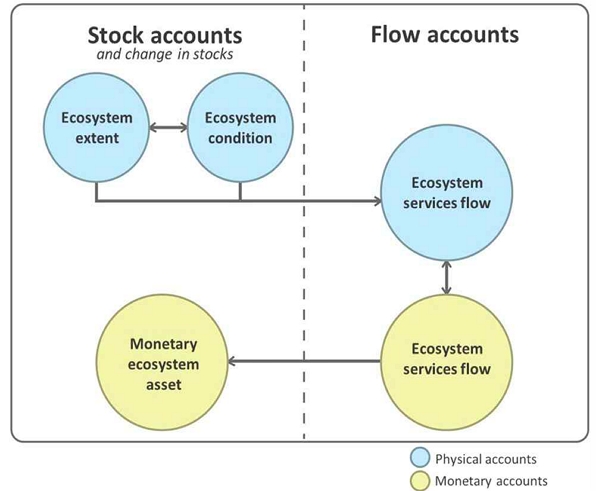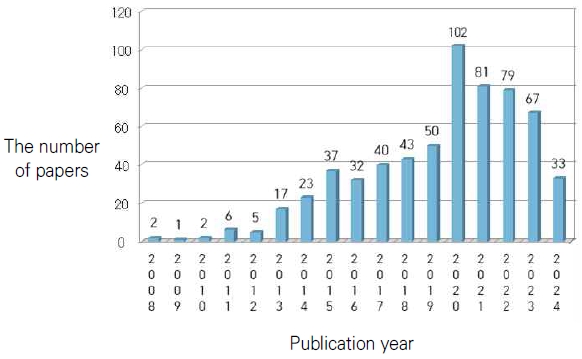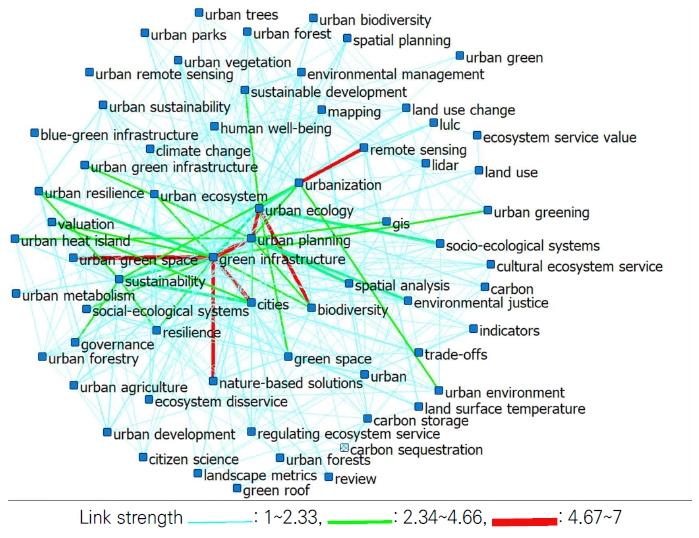
International Research Trends on Urban Ecosystem Services
Abstract
This study aims to identify international research trends related to urban ecosystem services in the context of the growing importance of responding to climate change and conserving biodiversity in urban areas. Based on these findings, the study seeks to suggest directions for environmental policies to achieve a more sustainable environment. To this end, the study analyzes the keywords that frequently appear in the bibliographic data of academic papers on urban ecosystem services and their relationships through network analysis. The study found that papers related to urban ecosystem services first appeared in 2008 and have gradually increased in academic publications over time. These papers have been overwhelmingly published in the field of urban studies. Notably, since the 2020s, there has been a surge in related papers, with studies emerging that use remote sensing technology to assess land use and cover from a climate change perspective to identify nature-based solutions. According to the results of the network analysis, research on urban ecosystem services has been intensively conducted in the area of urban planning, focusing primarily on “urban ecology” and “green infrastructure.” Therefore, urban planning policies that establish the infrastructure supporting the enhancement of urban ecosystem services are needed.
Keywords:
Urban Ecosystem, Ecosystem Services, Green Infrastructure, Urban Planning, Urban Ecology, Climate ChangeI. Introduction
The urban densification, mass production, and overconsumption have led to substantial resource and energy inputs, resulting in environmental pollution and contributing to a global crisis driven by climate change (United Nations Environment Programme, 2000). The ongoing process of urbanization has encroached on green spaces, which are vital for mitigating the climate crisis, leading to a decline in biodiversity (Pauleit, Ennos, and Golding, 2005; Goddard, Dougill, and Benton, 2013) As a result, urban societies have become increasingly disconnected from ecosystems, yet the demand for urban ecosystem services has steadily risen to reduce environmental burdens and improve citizens’ health and quality of life (Gómez-Baggethun and Barton, 2013).
In 2012, the experimental ecosystem accounting was established to continuously collect and provide data and information related to ecosystems for the conservation of biodiversity and natural capital, as well as to monitor the environment, as part of the System of Environmental Economic Accounting (hereinafter SEEA) (UN, 2014b). In 2021, the United Nations Statistical Commission adopted the SEEA ecosystem accounting (SEEA-EA) framework to actively promote ecosystem accounting, which complements the previously established experimental ecosystem accounting (UN et al., 2021). The United Nations (hereinafter UN), in enhancing the value of ecosystem services, established the Sustainable Development Goals (SDGs) from 2016 to 2030, including two of the 17 main goals aimed at the protection and restoration of aquatic and terrestrial ecosystems (UN Statistical Division, 2015). Ecosystem services, by utilizing the components of ecosystems, enhance human well-being and can strengthen the sustainability and resilience of urban environments pressured by climate change through the provisioning, regulating, cultural, and supporting services they provide (Boyd and Banzhaf, 2005). Therefore, to enhance urban ecosystem services, it is essential to understand the trade-offs and synergies among the diverse and complex ecosystem services (Song et al., 2023). While urban ecosystem services can serve as a means for sustainable and resilient urban planning, pursuing innovative pilot projects based on ecosystem services may be limited and carry risks. Therefore, it is necessary to establish a framework for safe urban design that accommodates interdisciplinary collaboration among various stakeholders and allows for the possibility of failure (Ahern, Cilliers, & Niemelä, 2014).
Therefore, this study aims to identify the trends and key topics in various research studies related to urban ecosystem services conducted internationally, in order to establish a foundation for supporting urban planning decisions that enhance citizens’ health, safety, and quality of life while also providing beneficial ecosystem services for other species, thereby creating a healthy and sustainable urban environment..
Ⅱ. Literature Review
1. Ecosystem services
With the arrival of the 2000s, the UN, together with over 1,300 scientists from various countries, conducted the Millennium Ecosystem Assessment by 2005. This assessment focused on the linkages between ecosystems and human well-being and, in particular, on ‘ecosystem services’. In this assessment, ecosystem services were defined as “the benefits people obtain from ecosystems” to describe the products and services of biodiversity (Millenium Ecosystem Assesment, 2005). In 2019, the European Commission (hereinafter EC) announced the European Green Deal plan, which aims to protect Europe’s natural capital, which is the source of ecosystem services, and reduce environmental pollution through new circular economy practices to set Europe to a path towards climate neutrality by 2050 and define actions to reach that goal (EC, 2019).
The extent and condition of ecosystems influence the potential for ecosystem services to flow from ecosystems to humans. When the demand for ecosystem services increases, it often results in a reduction in the potential of these services, which can even lead to a situation where they can no longer meet the ongoing demand (Maes et al., 2020). On 20 May 2020, the EC adopted an EU Biodiversity Strategy for 2030 (EC, 2021). The strategy presents an ambitious agenda on bending the trend in biodiversity loss with increasing emphasis on ecosystem restoration. Ecosystems are seen as solutions, not only to protect biodiversity but also to enhance carbon uptake and contribute to climate change mitigation a well as to deliver essential benefits to people, agriculture, and the economy (Maes and Jacobs, 2017). As of 2024, most complaints related to parks in South Korea were found to focus on gray infrastructure, such as parking lots and restrooms, indicating a lack of public awareness and interest in ecosystem services associated with green infrastructure (Jeong et al., 2024).
2. Ecosystem accounting
The EC proposed the SEEA, a multipurpose system that integrates economic and environmental data to provide comprehensive statistics, accounts, and indicators on the interrelationships between the economy and the environment, as well as the accumulation and changes in environmental assets. This standard guideline aims to unify economic, environmental, and social data into a consistent framework for overall decision-making (UN, 2014a). In March 2021, at its 52nd session, the United Nations Statistical Commission adopted the SEEA-EA. This integrated and comprehensive statistical framework was designed to organize data on habitats and landscapes, measure ecosystems, and track changes in ecosystem assets, linking relevant information to the economy and other human activities (UN et al., 2021). The UN describes SEEA-EA in monetary terms to express the social contributions of ecosystems, making it easier to compare their contributions to social welfare with familiar goods and services. It is divided into five accounts: ecosystem extent, ecosystem condition, physical ecosystem service, monetary ecosystem service, and monetary ecosystem asset account <Figure 1>.
3. Urban ecosystem service accounting
To achieve national goals for carbon emission reductions in response to the climate crisis, it is essential to establish urban-level reduction targets through ecosystem services that have the potential to effectively implement climate change mitigation policies in cities via biological carbon storage. Davies et al. (2011) conducted a study to map urban ecosystem services to quantify carbon storage at the city-wide scale. They suggested the potential benefits of aboveground vegetation management for solving carbon emissions problems within typically urbanized European cities (Davies et al., 2011). In this way, restoring urban ecosystems to activate ecosystem services is not only ecologically and socially desirable, but it is often economically beneficial as well (Elmqvist et al., 2015).
In 2015, the ‘Integrated System of Natural Capital Accounting (hereinafter, INCA)’ project was initiated by the EC and the European Environment Agency (EEA) to develop ecosystem service accounts. The European Union (hereinafter, EU) member states set a goal to develop preliminary pilot ecosystem accounts aligned with the SEEA-EA by 2020 (La Notte et al., 2017). In 2021, the second-phase report of the INCA project was completed, focusing on the development of a pilot integrated system for EU ecosystem accounts. However, there were relatively few accounts focused on urban ecosystems (Heris et al., 2021). In response, urban ecosystem accounts were established in 2023 for pilot application in European cities based on the SEEA-EA framework (Babi Almenar et al., 2023). Urban ecosystem services, which provide numerous benefits to humans, should be managed and optimized based on an understanding of the interactions between urban ecosystems and social and economic systems as a means to promote sustainable urban development (Ouyang and Luo, 2022). The United Kingdom is a leader in advancing ecosystem accounting at the urban level, quantifying the value of urban ecosystem services (Dickie & Neupauer, 2019). Following this, in 2021, the United States launched a pilot project for urban ecosystem accounting using the SEEA-EA framework, targeting over 700 mid-sized to large cities (Heris et al., 2021).
Ⅲ. Data and Methodology
1. Data collection and basic analysis.
In this study, we collected bibliographic information from 620 papers related to urban ecosystem services published in the international academic community from 2008 to August 2024 using the Web of Science (hereinafter WoS) database developed by Clarivate Analytics, which provides bibliographic data on research outputs in prominent academic journals. During the literature collection process, we constructed a query to search for documents containing the two keywords, “urban ecosystem service” and “urban ecosystem services” in the keywords and abstracts of the research literature. We extracted information such as publication year, research field, and research keywords from the bibliographic information of these documents to identify the basic characteristics of the literature and investigate the co-occurring topics.
2. Network analysis
Using the bibliographic information obtained from the WoS database, we visualized the keywords of the research literature as nodes and connected related nodes with links based on the co-occurrence of keywords, thereby constructing a network of their interrelationships. Based on the constructed network, we calculated the attributes of the nodes and links. The visualization and analysis of the network were conducted using the VOSviewer (Van Eck and Waltman, 2010) and Ucinet (Borgatti et al., 2002) programs.
The aforementioned network represents the research topics and their relationships transformed into nodes and links. Through this network, we calculated link strength and total link strength, which serve as indicators for assessing the degree of mutual relationships among the topics.
In network analysis, we calculated degree centrality, eigenvector centrality, and betweenness centrality for each topic that makes up the network to understand the prominence and relationships of each topic. The concepts and characteristics of each centrality measure are as follows:
(1) Degree centrality
Among the centrality measures, degree centrality is calculated by considering only the nodes that are directly connected to the node of interest, making it suitable for identifying centrality at a local level rather than at an overall network level. This measure analyzes the state in which a specific node is directly connected to adjacent nodes based on the number of links associated with each node. Degree centrality is used to identify nodes that are likely to hold a substantial amount of information (Freeman, 1978). In this study, the formula for calculating degree centrality, used to identify topics that are directly related to a significant amount of information at a local level, is given in equation (1).
| (1) |
Where, CD(i) represents the degree centrality of node i, and Aij indicates the connection status between nodes i and j (connected: 1, not connected: 0).
(2) Eigenvector centrality
Eigenvector centrality is a measure that calculates the importance of a node by applying the centrality of other connected nodes as weights. A high eigenvector centrality indicates that a node has significant influence, even if its degree centrality is low. Conversely, if a node has high degree centrality but low eigenvector centrality, it can be interpreted as having weak actual influence (Bonacich, 2007). In this study, the formula for calculating eigenvector centrality, used to identify keywords with substantial influence in the network, is given in equation (2).
| (2) |
Where, CE(i) represents the eigenvector centrality of node i, λ is the eigenvalue (constant) associated with node i, Aij indicates the connection status between nodes i and j (connected: 1, not connected: 0), and CE(j) denotes the eigenvector centrality of node j.
(3) Betweenness centrality
Betweenness centrality measures the frequency with which a specific node lies on the shortest paths between other nodes, serving as an indicator to identify nodes that connect different parts of the network. A node with high betweenness centrality is interpreted as having significant mediating influence (Freeman, 1978). In this study, the formula for calculating betweenness centrality, used to identify keywords with high mediating influence among leading topics, is given in equation (3).
| (3) |
Where, CB(i) represents The betweenness centrality for node i, Gjk(i) indicates the number of shortest paths between nodes 𝑗 and 𝑘 that pass through node i, and Gjk denotes The total number of shortest paths between nodes j and k.
Ⅳ. Results and Discussion
1. Basic trends
According to the basic analysis of the bibliographic information of the collected research papers, the studies related to ‘urban ecosystem services’ began with a small number of publications in 2008, saw a sharp increase in the mid-2010s, and once again experienced a surge in the number of publications as we entered the 2020s <Figure 2>.
These studies have been conducted across various fields. Notably, it was found that the most research (496 cases) was carried out in the field of ‘Environmental Sciences & Ecology,’ followed by a significant number of studies (147 cases) in the field of ‘Urban Studies’. Regarding the UN’s 17 Sustainable Development Goals (SDGs), the largest number of research papers, 473 in total, were related to the 11th goal, ‘Sustainable Cities and Communities.’ This was followed by a substantial number of studies, 349 in total, related to the 15th goal, ‘Life on Land’ <Table 1>.
2. Research topics
From the bibliographic information of 620 research papers reviewed in this study, a total of 1,915 keywords were collected. Among them, 70 keywords were found to have co-occurred in five or more papers. Excluding the keywords used for the literature search, such as ‘urban ecosystem services,’ ‘ecosystem services,’ and ‘urban ecosystem,’ the relationships among the remaining 67 keywords were analyzed and visualized as a network using the ‘VOS viewer’ program.
First, based on the average publication year of the bibliographic data, the temporal changes in research topics were identified. The results indicate that, shortly after the mid-2010s, research primarily focused on ‘urban ecology’ related to ‘carbon’ and ‘urban biodiversity.’ In the late 2010s, a transitional period, research trends were dominated by studies on ‘green infrastructure’ related to ‘urban trees,’ ‘urban greening,’ and ‘urban resilience’ from an urban planning perspective. In the 2020s, the focus shifted toward studies using remote sensing technology to assess ‘land use and land cover (LULC)’ in the context of climate change and to explore nature-based solutions.
In addition, it was found that during this period, studies on blue infrastructure related to services provided by water space were born following studies on green infrastructure.
The network analysis results indicated that among the 67 selected keywords, ‘green infrastructure’ showed a very strong link strength (hereinafter LS) with ‘cities,’ ‘nature-based solutions,’ and ‘urban ecology.’ A strong LS was also found between ‘urban ecology’ and ‘biodiversity,’ as well as between ‘urbanization’ and ‘remote sensing’ <Figure 4>. Overall, ‘green infrastructure’ emerged as having the strongest total link strength (hereinafter TLS). Additionally, the kewords such as ‘urban planning,’ ‘urban ecology,’ ‘urbanization,’ ‘cities,’ ‘sustainability,’ and ‘biodiversity’ were also identified to have high TLSs, indicating that they are key topics driving research in urban ecosystem services <Table 2>.
(1) Degree centrality
According to the analysis of degree centrality in the network composed of keywords from the research literature, among the research topics related to ‘urban ecosystem services,’ the keyword most directly linked to the largest number of keywords is ‘green infrastructure’ <Figure 5>. This indicates that many studies have been conducted to enhance the functions of ecosystem services by establishing the green infrastructure in urban areas. Additionally, ‘urban planning’ and ‘urban ecology’ were also identified as keywords directly linked to many other keywords. Notably, ‘urban planning’ was analyzed as a keyword that forms a direct and close relationship with both ‘urban ecology’ and the aforementioned ‘green infrastructure.’
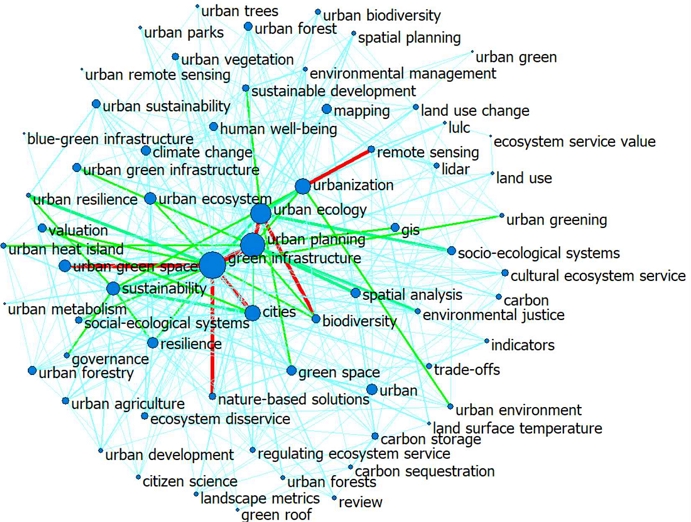
Results of the degree centrality calculation for research keywordsWhere, the size of a node (circle) indicates the degree centrality of the corresponding keyword
(2) Eigenvector centrality
According to the eigenvector centrality analysis, which calculates centrality by considering the importance of surrounding nodes in addition to directly related nodes, the overall results appear similar to those of the degree centrality analysis. However, as shown in <Figure 6>, it is notable that the size of node corresponding to ‘urbanization’ is larger, indicating a higher eigenvector centrality value for this node compared to the degree centrality shown in <Figure 5>. This suggests that ‘urbanization’ is a significant keyword associated with other important keywords, highlighting its prominence.
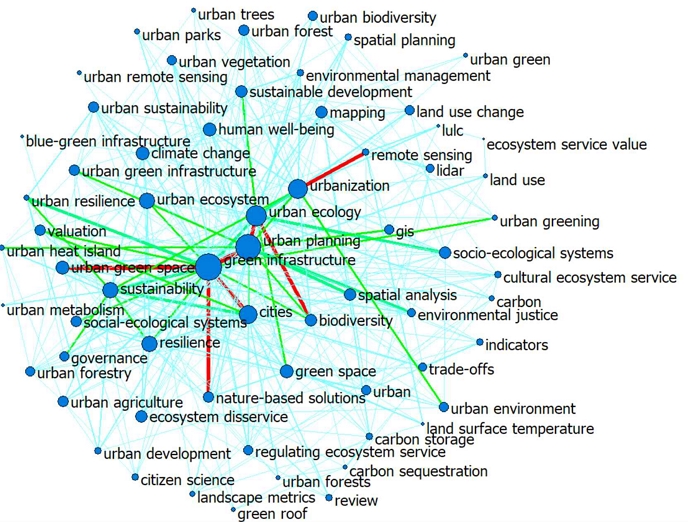
Results of the eigenvector centrality calculation for research keywordsWhere, the size of a node (circle) indicates the eigenvector centrality of the corresponding keyword
(3) Betweenness centrality
According to the results of betweenness centrality analysis, which measures the mediating role that a node plays in forming a network with other nodes, the size of the node for ‘urbanization’ was found to be significantly smaller compared to the nodes corresponding to the eigenvector centrality analyzed above <Figure 7>. This means that although urbanization can be an important topic of research, its mediating role in linking other research topics related to urban ecosystem services is weak. On the other hand, ‘green infrastructure’ was found to be an important keyword in linking other topics as a mediating factor. Therefore, ‘green infrastructure’ was found to be the keyword with the highest centrality values across all three centrality indices mentioned above.
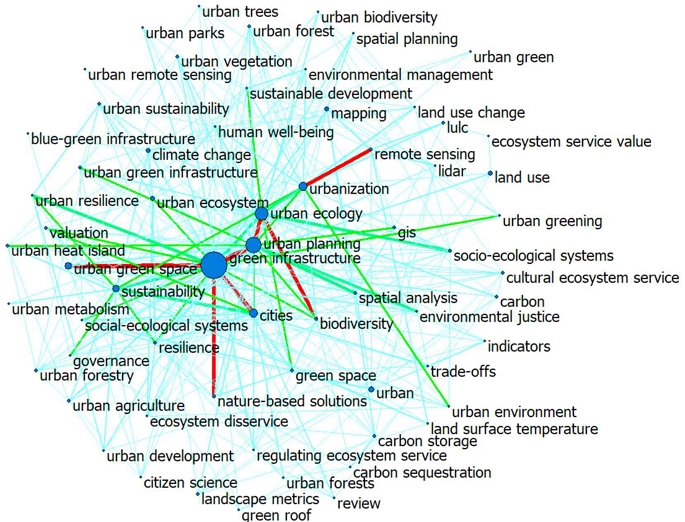
Results of the betweenness centrality calculation for research keywordsWhere, the size of a node (circle) indicates the betweenness centrality of the corresponding keyword
Particularly, if studies related to ‘environmental justice,’ which exhibit very low values in the three major centrality indicators, including betweenness centrality, are linked with studies on ‘green infrastructure,’ which demonstrate very high centrality values, and their direct or mediating influence is enhanced, it is expected that environmental policies could be developed to equitably provide urban ecosystem services based on green infrastructure to all citizens.
Ⅴ. Conclusion
This study identified the trends of studies related to urban ecosystem services, which were conducted in the international academic community to secure evidence-based materials supporting decision-making in urban planning aimed at realizing sustainable cities based on ecosystem services.
According to the basic analysis results, studies related on urban ecosystem services have been attempted in various fields, with particularly many studies conducted in environmental science, ecology, and urban studies. In relation to the UN’s Sustainable Development Goals, the studies have mainly been focused on ‘Sustainable Cities and Communities’ and ‘Life on Land.’ The aforementioned studies emerged in the late 2000s and surged in the mid-2010s. During this period, research primarily focused on urban ecology aimed at reducing carbon emissions and conserving urban species. From the late 2010s, studies increasingly centered on urban greening and building urban resilience through green infrastructure from an urban planning perspective. Entering the 2020s, studies began to focus on finding nature-based solutions to adapt to and respond to the climate crisis, using remote sensing technology via satellites to more accurately analyze urban land use.
The results of network analysis on the keywords extracted from the bibliographic data of these studies indicate that ‘green infrastructure’ is the most important topic addressed, with many studies focusing on establishing such infrastructure in cities to enhance ecosystem service functions. In particular, it can be inferred that this green infrastructure serves as a means of providing ecosystem services to solve problems arising from urbanization as a nature-based solution in urban planning. Therefore, in the process of developing environmental policies aimed at realizing sustainable cities, green infrastructure that supports ecosystem services should be actively introduced and utilized. Furthermore, cities should be regarded as integrated socio-ecological systems, and institutional policies should be activated from an urban ecological perspective to achieve environmental justice.
Acknowledgments
This research was conducted as part of the National Institution of Ecology’s research project, “Development of Policy Decision Support System based on Ecosystem Services Assessment” (Project No.: NIE-B-2024-03).
References
-
Ahern, J., S. Cilliers, and J. Niemelä, 2014, “The concept of ecosystem services in adaptive urban planning and design: A framework for supporting innovation,” Landscape and Urban Planning, 125, pp.254-259.
[https://doi.org/10.1016/j.landurbplan.2014.01.020]

-
Babi Almenar, J., F. Marando, S. Vallecillo, G. Zulian, C. Cortinovis, M. Zurbaran-Nucci, N. Chrysoulakis, D. Parastatidis, M. Heris, and I. Grammatikopoulou, 2023, Urban ecosystem accounts following the SEEA EA standard: A pilot application in Europe – Report on an Integrated System for Natural Capital Accounting in the EU (INCA), Luxembourg: Publications Office of the European Union. https://data.europa.eu/doi/10.2760/741116
[https://doi.org/10.2760/741116]

- Borgatti, S. P., M.G. Everett, and L.C. Freeman, 2002, Ucinet 6 for Windows: Software for social network analysis, Harvard, MA: Analytic Technologies.
-
Bonacich, P., 2007, “Some unique properties of eigenvector centrality,” Social Networks, 29(4), pp.555-564.
[https://doi.org/10.1016/j.socnet.2007.04.002]

- Boyd, J. W., H. S. Banzhaf, 2005, “Ecosystem services and government: The need for a new way of judging nature’s value,” Resources, 158, pp.16–19.
-
Davies, Z. G., J. L. Edmondson, A. Heinemeyer, J. R. Leake, and K. J. Gaston, 2011, “Mapping an urban ecosystem service: Quantifying above-ground carbon storage at a city-wide scale,” Journal of Applied Ecology, 48(5), pp.1125-1134.
[https://doi.org/10.1111/j.1365-2664.2011.02021.x]

-
Dickie, I. and S. Neupauer, 2019, “Natural capital accounts: nations and organizations,” Journal of Environmental Economics and Policy, 8(4), pp.379-393.
[https://doi.org/10.1080/21606544.2019.1639219]

- EC, 2019, Communication from the commission to the European Parliament, the Council, the European Economic and Social Committee and the Committee of the Regions, The European Green Deal, COM(2019) 640 final
-
EC, 2021, EU biodiversity strategy for 2030: Bringing nature back into our lives, Publications Office of the European Union.
[https://doi.org/10.2779/677548]

-
Elmqvist, T., H. Setälä, S. N. Handel, S. van der Ploeg, J. Aronson, J. N. Blignaut, E. Gómez-Baggethun, D. J. Nowak, J. Kronenberg, and R. de Groot, 2015, “Benefits of restoring ecosystem services in urban areas,” Current Opinion in Environmental Sustainability, 14, pp. 101-108.
[https://doi.org/10.1016/j.cosust.2015.05.001]

-
Freeman L. C., 1978, “Centrality in social networks conceptual clarification,” Social Networks, 1(1978/79), pp.215-239.
[https://doi.org/10.1016/0378-8733(78)90021-7]

-
Goddard, M. A., A. J. Dougill, and T. G. Benton, 2010, “Scaling up from gardens: Biodiversity conservation in urban environments,” Trends in Ecology and Evolution, 25(2), pp.90–98.
[https://doi.org/10.1016/j.tree.2009.07.016]

-
Heris, M., K. J. Bagstad, C. Rhodes, A. Troy, and A. Middel, K. G. Hopkins, and J. Matuszak, 2021, “Piloting urban ecosystem accounting for the United States,” Ecosystem Services, 48(18) Article 101226.
[https://doi.org/10.1016/j.ecoser.2020.101226]

-
Jeong, S.K., T.H. Lee, 2024, “Characteristics of Park-related Complaints Identified through Artificial Intelligence in Terms of Ecosystem Services”, Journal of Korea Institute of Ecological Architecture and Environment, 24(5), pp.53-59.
[https://doi.org/10.12813/kieae.2024.24.5.053]

- La Notte, A., S. Vallecillo, C. Polce, G. Zulian, and J. Maes, 2017, “Implementing an EU system of accounting for ecosystems and their services,” Initial proposals for the implementation of ecosystem services accounts, EUR, 28681, pp.1-124.
-
Maes, J., A. Teller, M. Erhard, S. Condé, S. Vallecillo, J. I. Barredo, M. L. Paracchini, D. Abdul Malak, M. Trombetti, O. Vigiak, G. Zulian, A. M. Addamo, B. Grizzetti, F. Somma, A. Hagyo, P. Vogt, C. Polce, A. Jones, A. I. Marin, E. Ivits, A. Mauri, C. Rega, B. Czúcz, G. Ceccherini, E. Pisoni, A. Ceglar, P. De Palma, I. Cerrani, M. Meroni, G. Caudullo, E. Lugato, J. V, Vogt, J. Spinoni, C. Cammalleri, A. Bastrup-Birk, J. San Miguel, S. San Román, P. Kristensen, T. Christiansen, N. Zal, A. de Roo, A. C. Cardoso, A. Pistocchi, I, Del Barrio Alvarellos, K. Tsiamis, E. Gervasini, I. Deriu, A. La Notte, R. Abad Viñas, M. Vizzarri, A. Camia, N. Robert, G. Kakoulaki, E. Garcia Bendito, P. Panagos, C. Ballabio, S. Scarpa, L. Montanarella, A. Orgiazzi, O. Fernandez Ugalde, F. Santos-Martín, 2020, Mapping and assessment of ecosystems and their services: An EU ecosystem assessment, EUR 30161 EN, Ispra: Publications Office of the European Union, ISBN 978-92-76-17833-0.
[https://doi.org/10.2760/757183,JRC120383]

-
Maes, J. and S. Jacobs, 2017, “Nature‐based solutions for Europe’s sustainable development,” Conservation Letters, 10(1), pp.121-124.
[https://doi.org/10.1111/conl.12216]

- Millennium Ecosystem Assessment, 2005, Ecosystems and human well-being: Synthesis, Washington, DC: Island Press.
-
Ouyang, X. Y. and X. Y. Luo, X, 2022, “Models for assessing urban ecosystem services: Status and outlooks,” Sustainability, 14(8), Article 4725.
[https://doi.org/10.3390/su14084725]

-
Pauleit, S., R. Ennos, and Y. Golding, 2005, “Modeling the environmental impacts of urban land use and land cover change: A study in Merseyside, UK,” Landscape and Urban Planning, 71(2-4), pp.295-310.
[https://doi.org/10.1016/S0169-2046(04)00083-0]

-
Song, L. L., M. Y. Wu, Y. Y. Wu, X. Y. Xu, and C. F. Xie, 2023, “Research on the evaluation of cultural ecosystem services in Zhengzhou urban parks based on public perceptions,” Sustainability, 15(15), Article 11964.
[https://doi.org/10.3390/su151511964]

- United Nations (UN), 2014a, System of environmental-economic accounting 2012 central framework, https://seea.un.org/sites/seea.un.org/files/seea_cf_final_en.pdf, .
- UN, 2014b, System of environmental-economic accounting 2012— Experimental ecosystem accounting, https://seea.un.org/sites/seea.un.org/files/seea_eea_final_en_1.pdf, .
- UN, European Union, Food and Agriculture Organization of the United Nations, International Monetary Fund Organisation for Economic Co-operation and Development, The International Bank for Reconstruction and Development, and The World Bank, 2021, System of environmental-economic accounting—Ecosystem accounting (SEEA-EA), White cover publication, pre-edited text subject to official editing, https://seea.un.org/ecosystem-accounting, .
- United Nations Statistical Division (UNSD), 2015, Discussion paper on principles of using quantification to operationalize the SDGs and criteria for indicator selection.
Jeong, Sang-Kyu: He is a professor in the Interdisciplinary Program of Smart Eco-Industrial Convergence at Chungbuk National University and has conducted research on decision support systems related to eco-city planning, eco-industrial development, and green building planning (neoshaky@chungbuk.ac.kr).
Ban, Yong-Un: He is a professor in the Department of Urban Engineering at Chungbuk National University and has conducted research in the fields of environmental justice, eco-cities, and eco-industrial parks to address and adapt to climate change (byubyu@chungbuk.ac.kr).
Lee, Tae-Ho: He received a PhD. in Urban Engineering from Chungbuk National University and is an associate researcher at the department of Ecosystem Services Team in National Institute of Ecology. His research fields include ecosystem services, environmental impact assessment, and natural capital account (utome@nie.re.kr).
